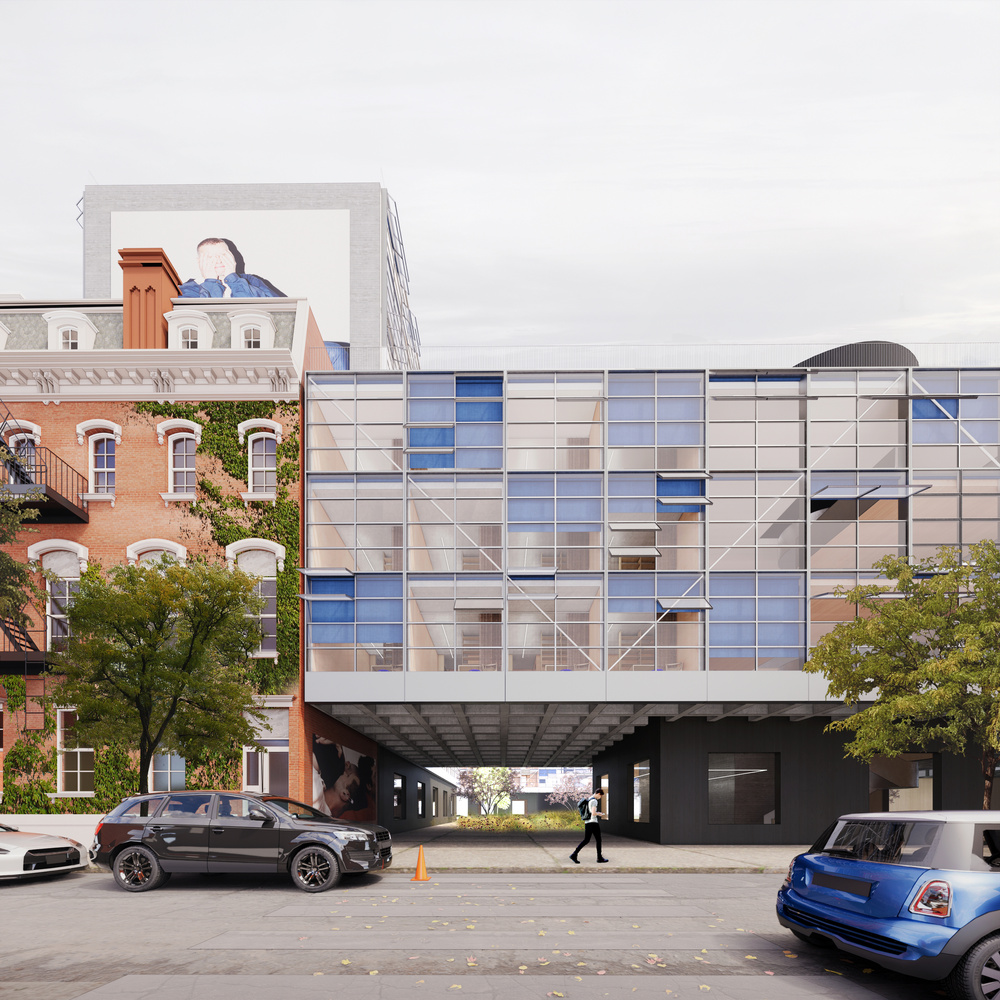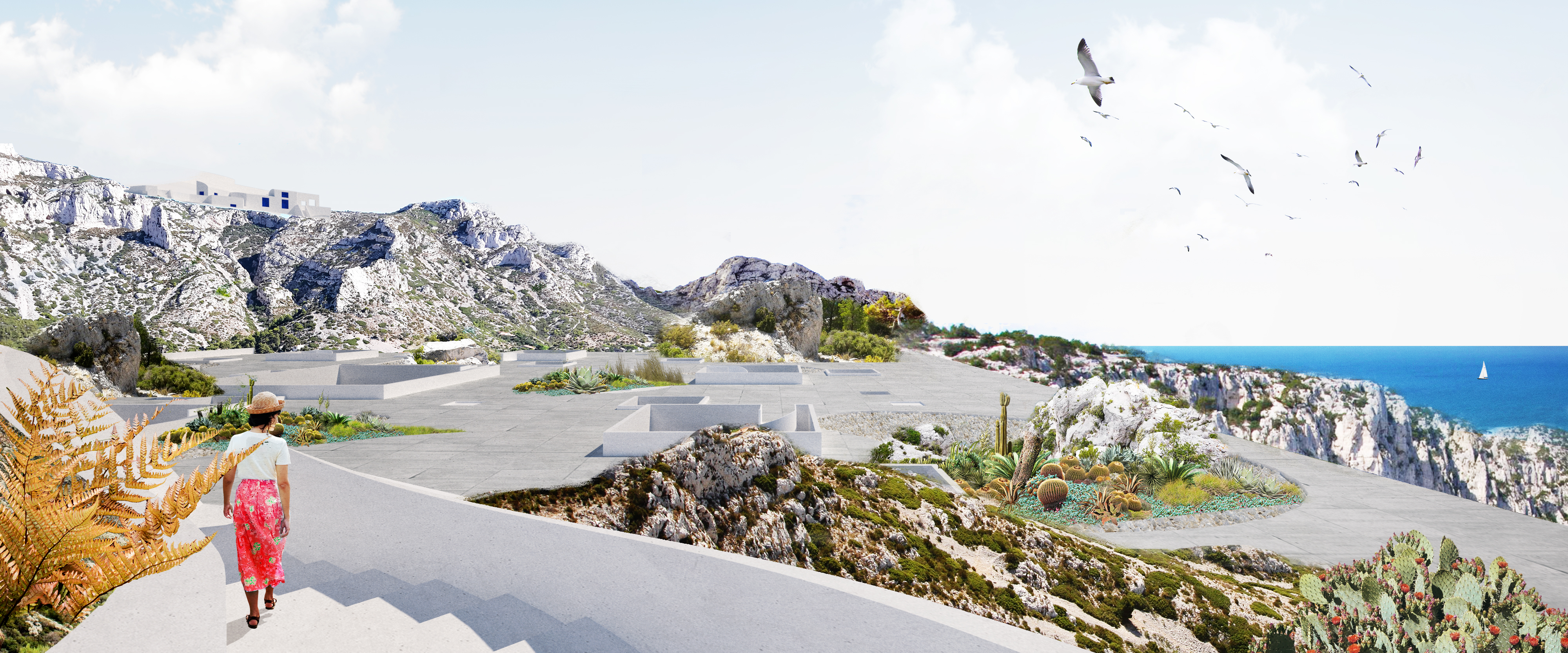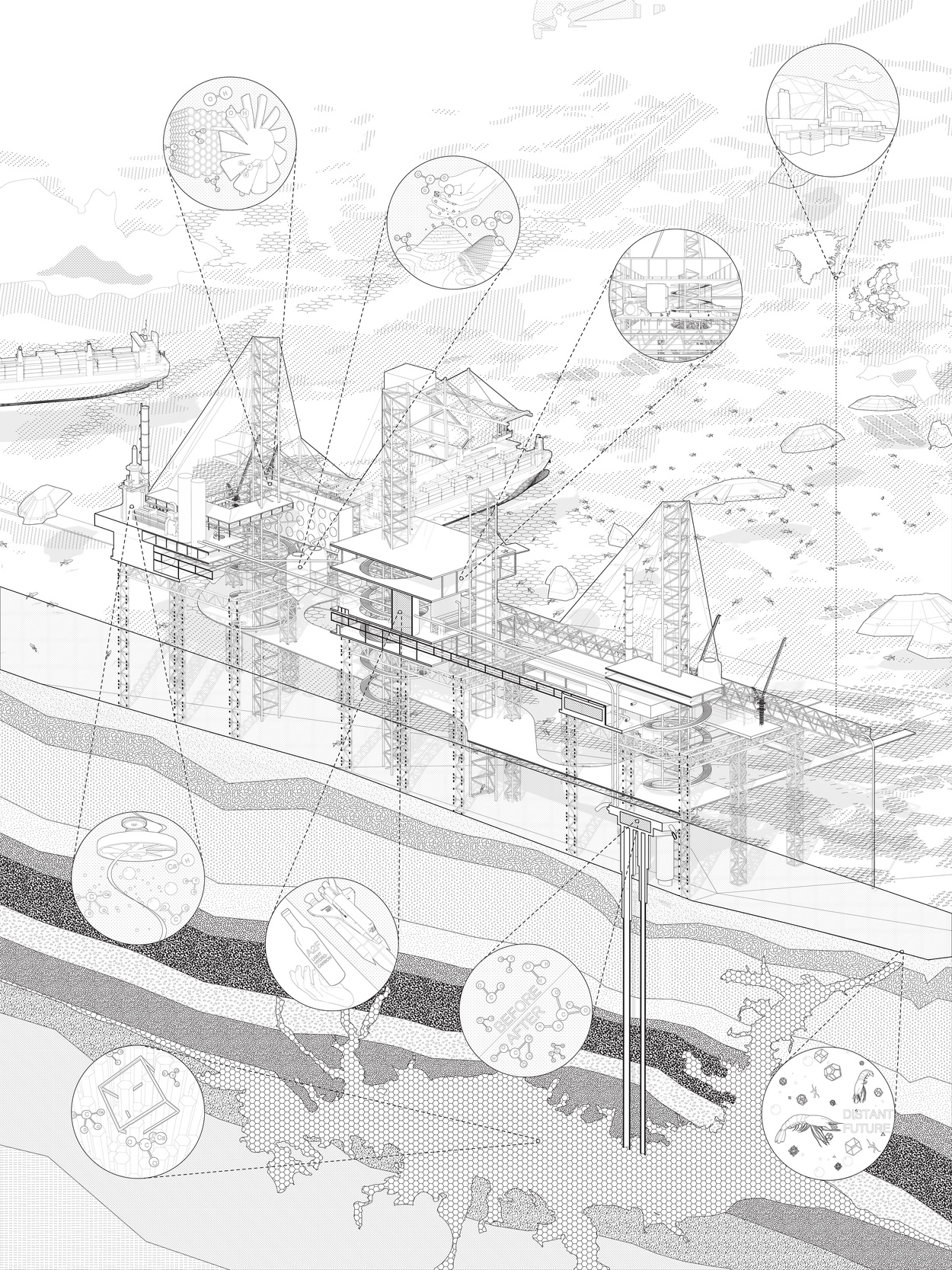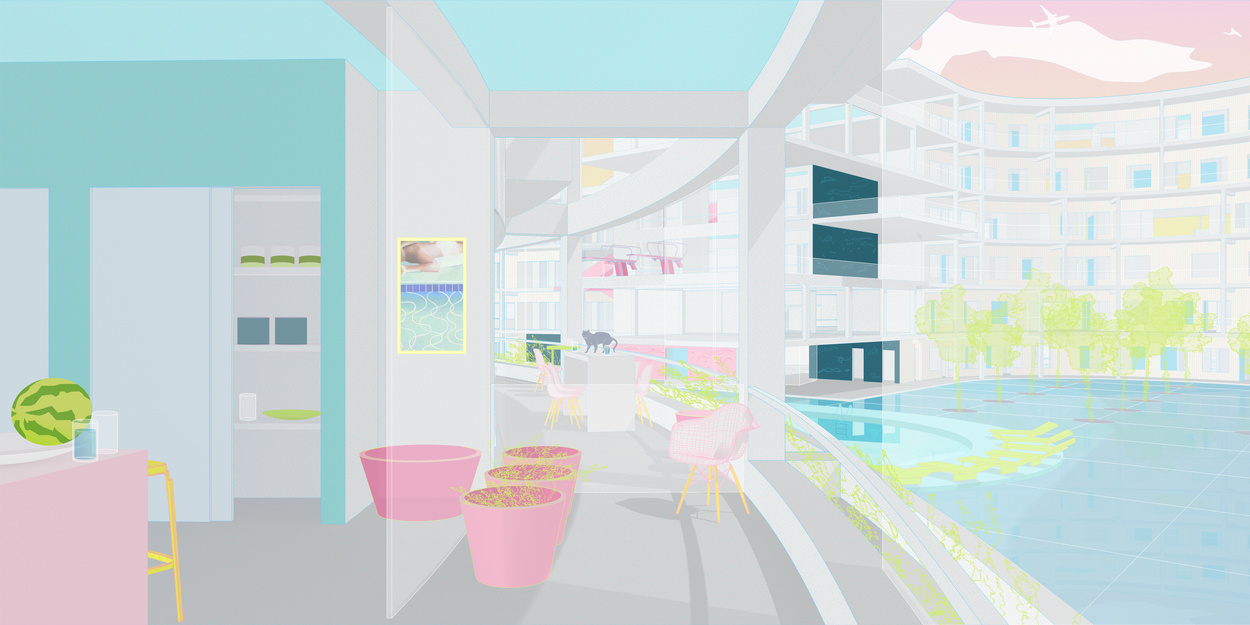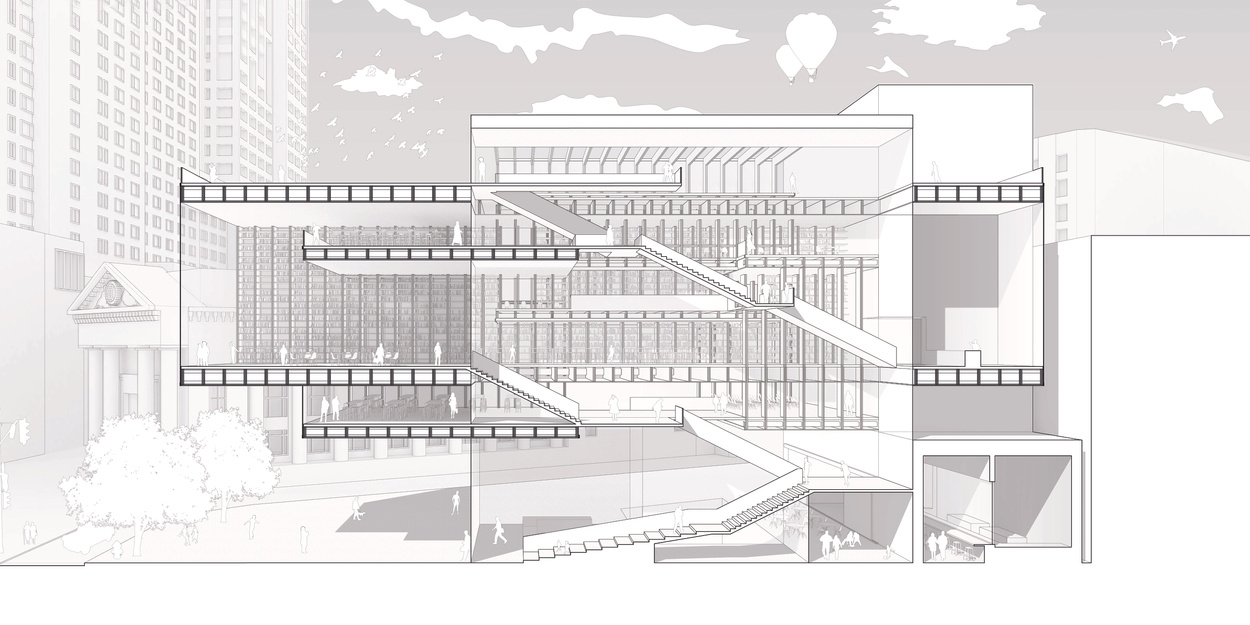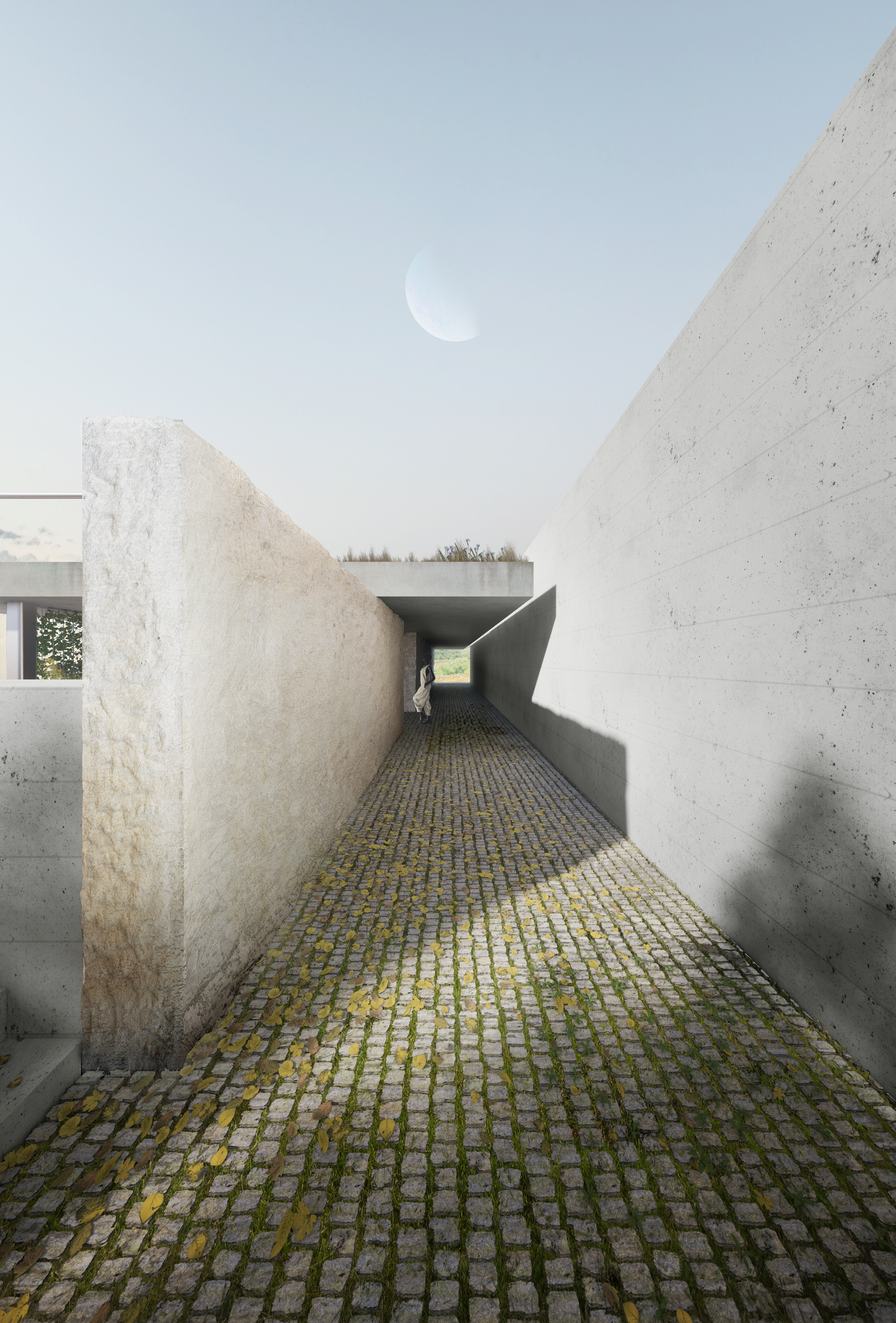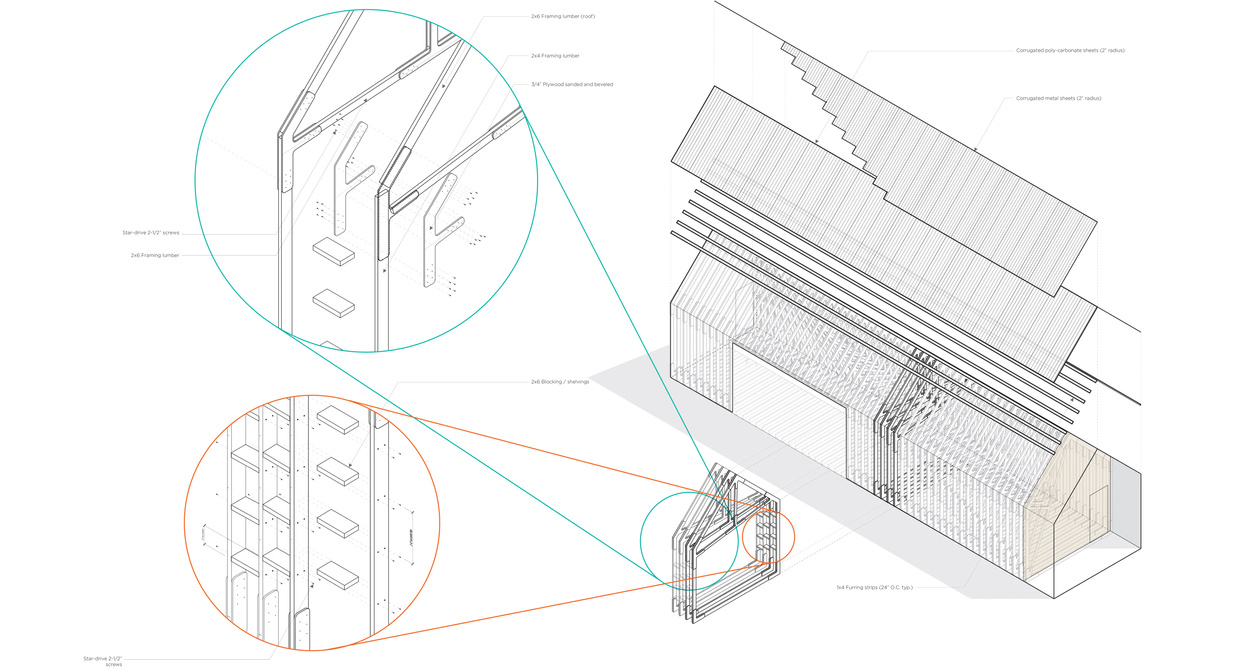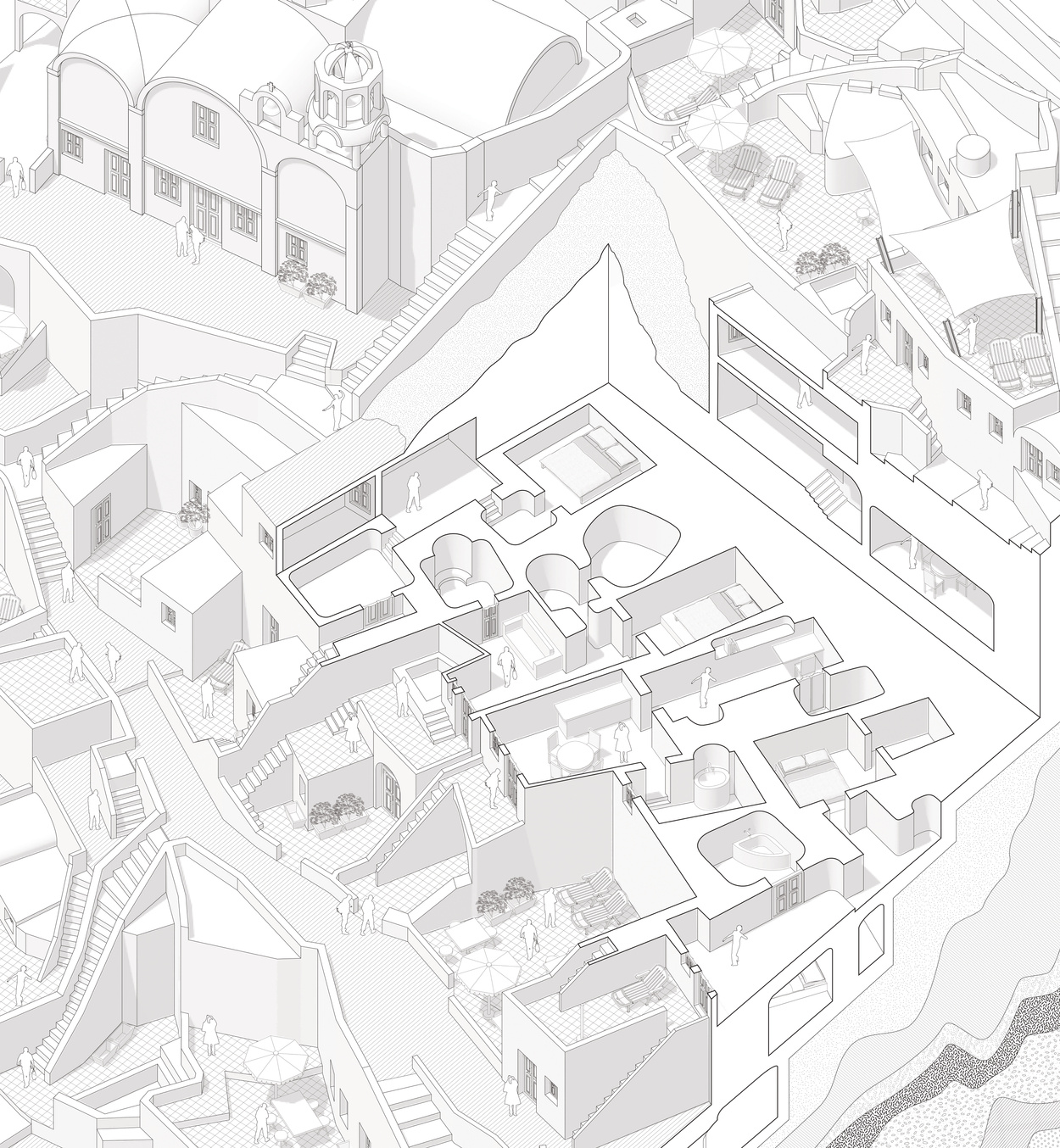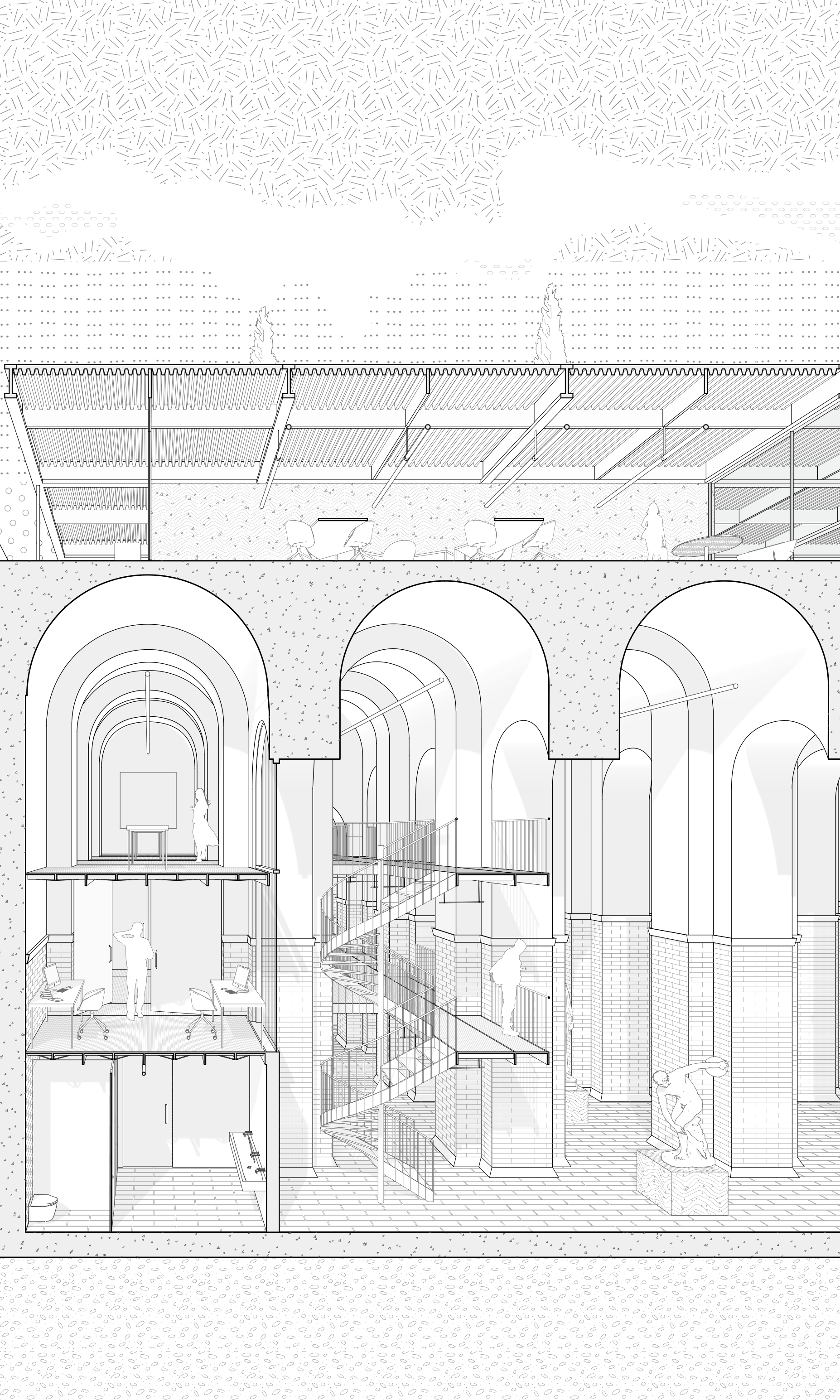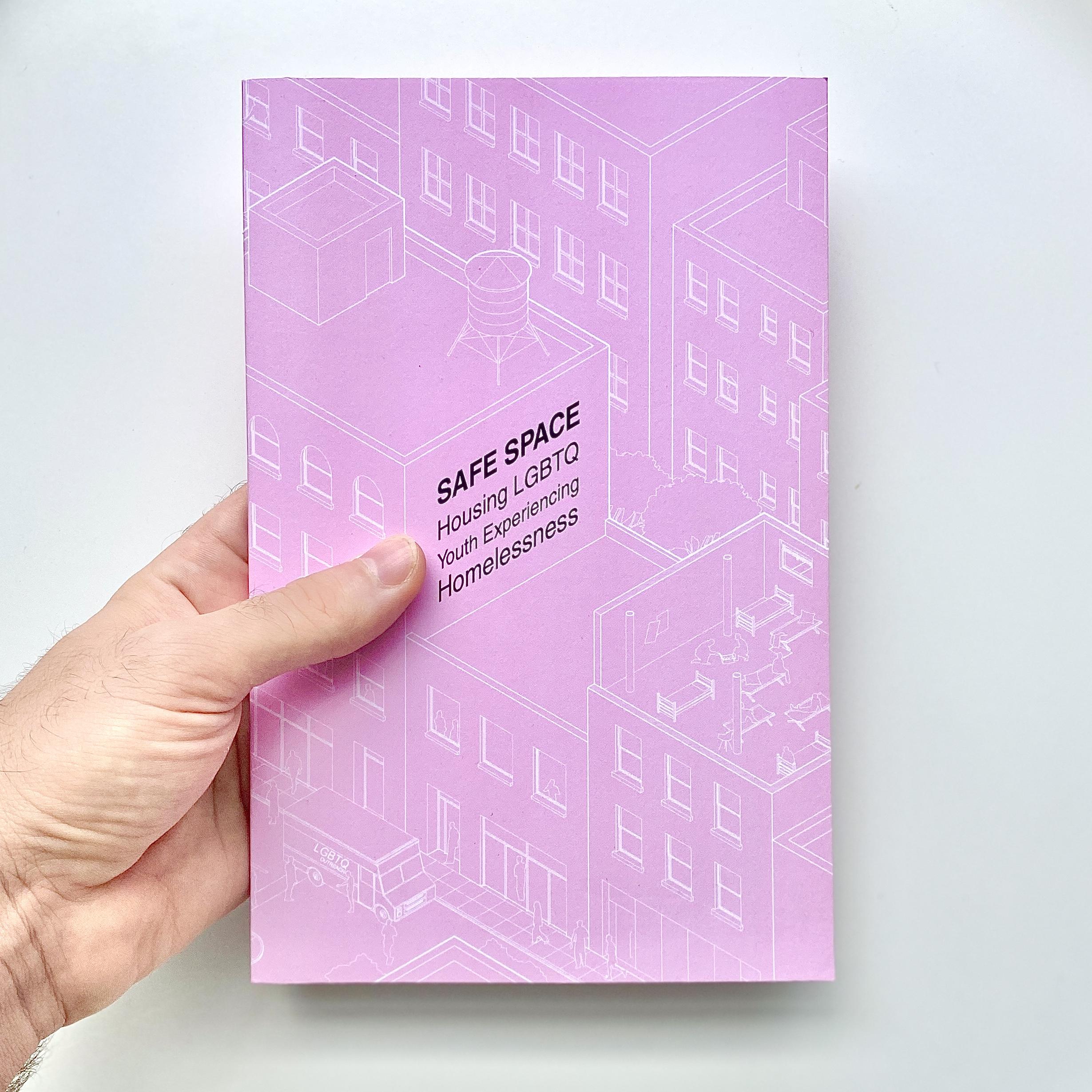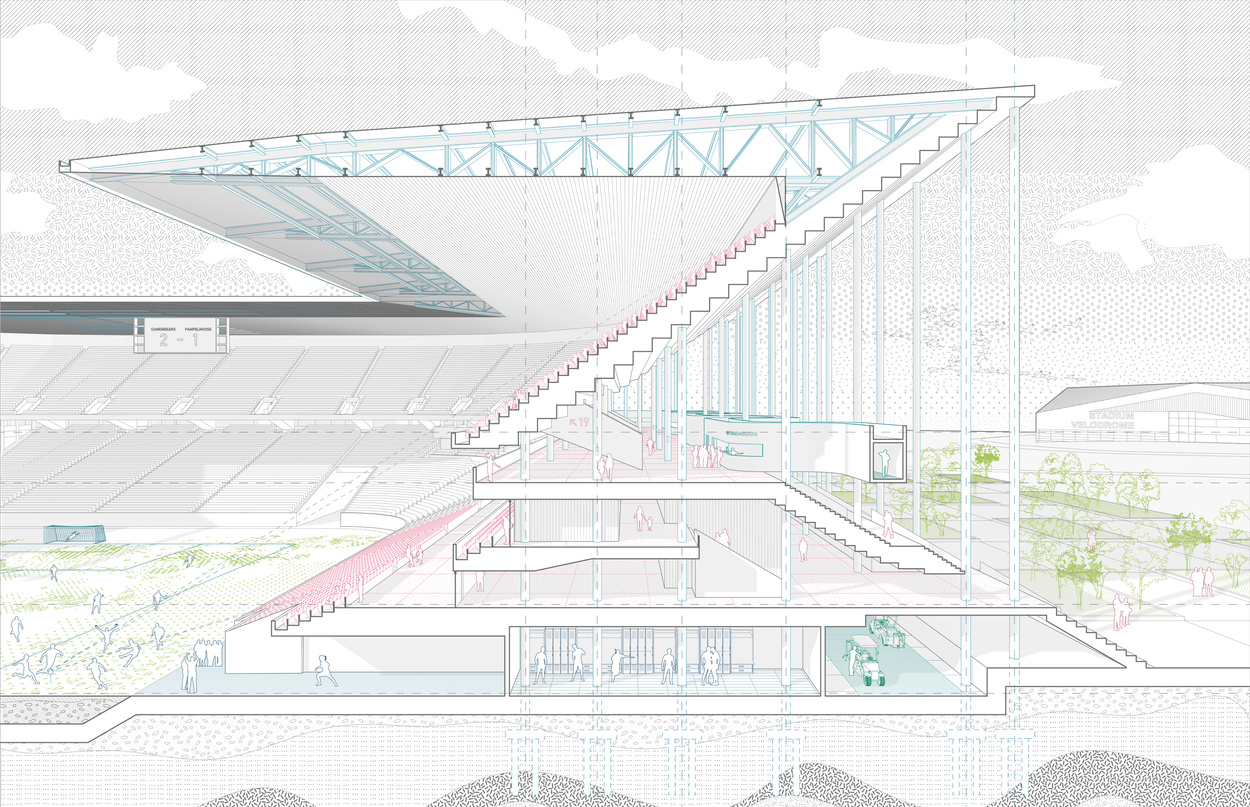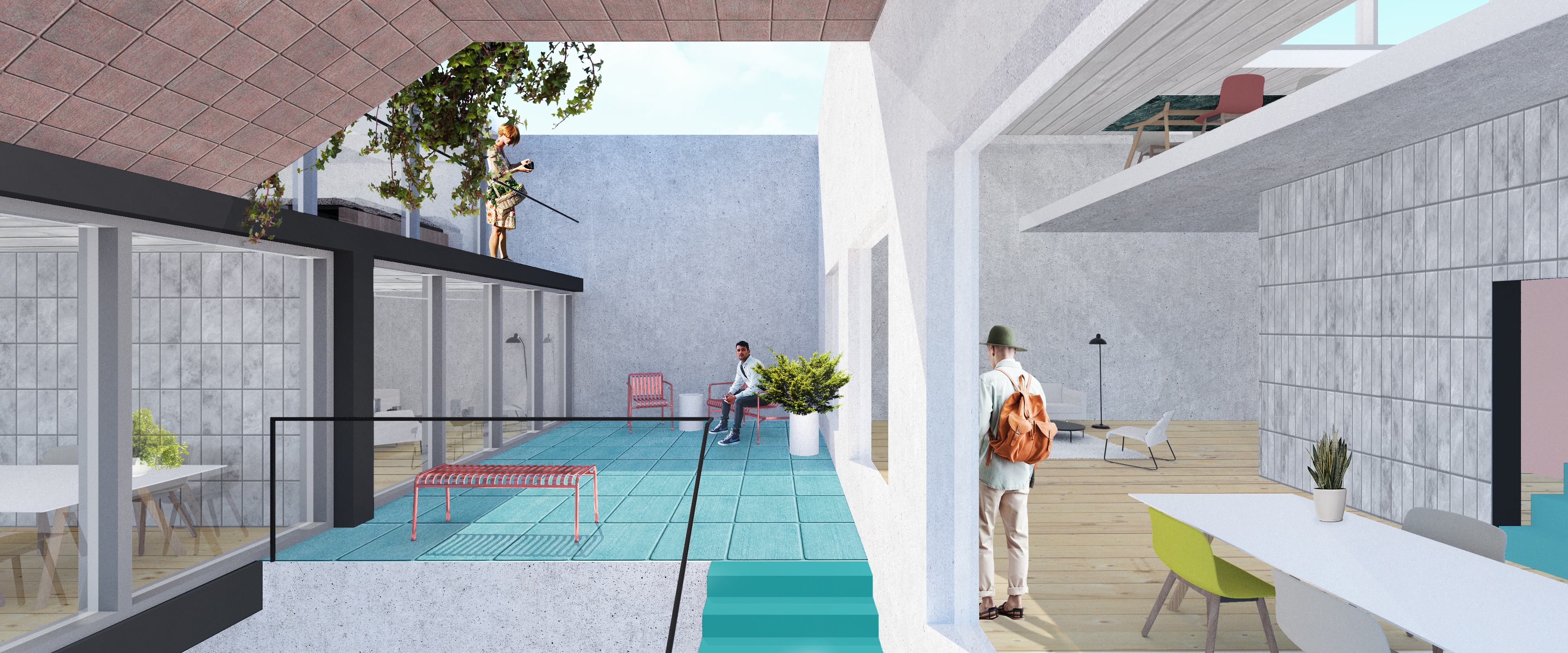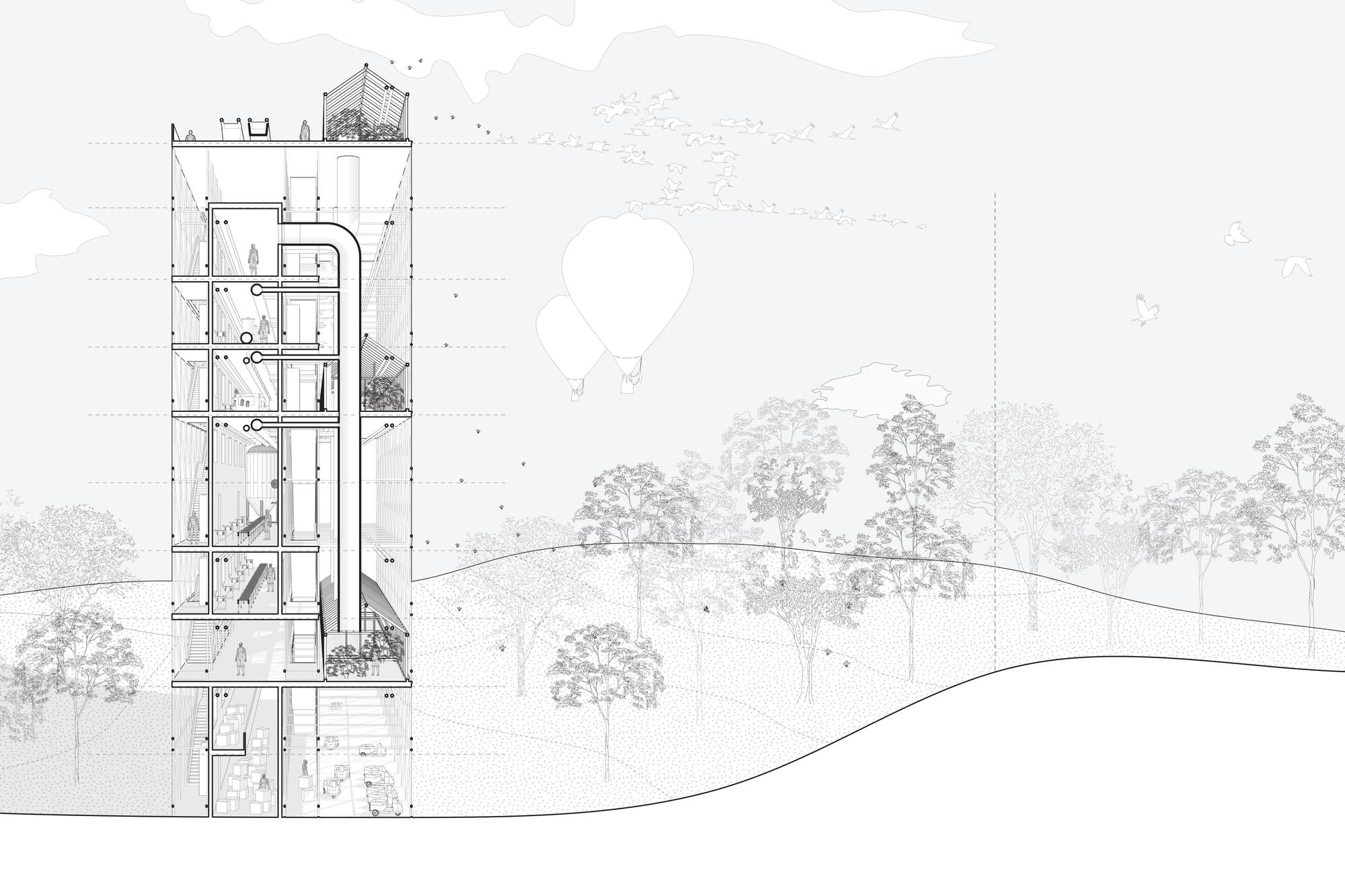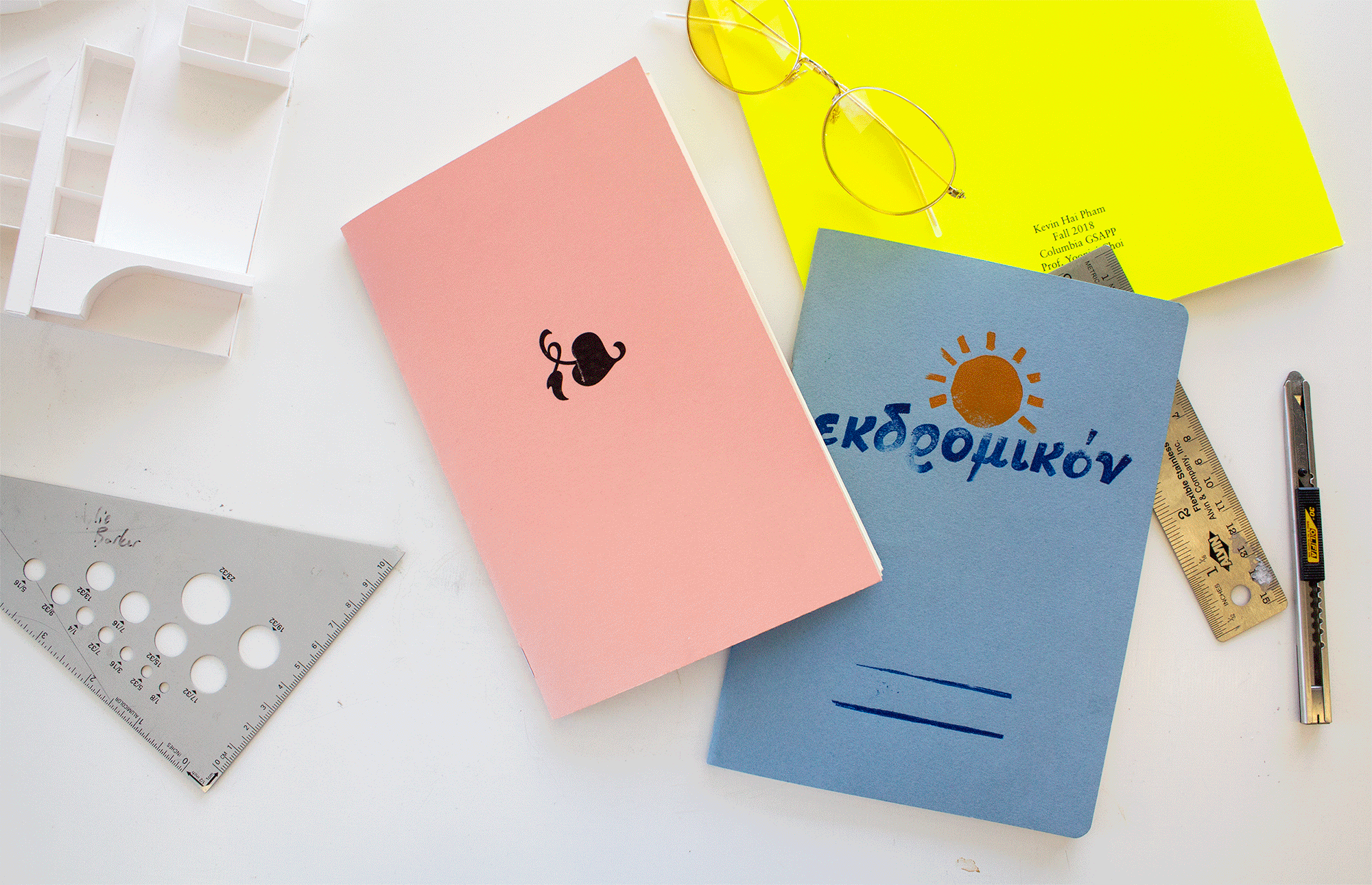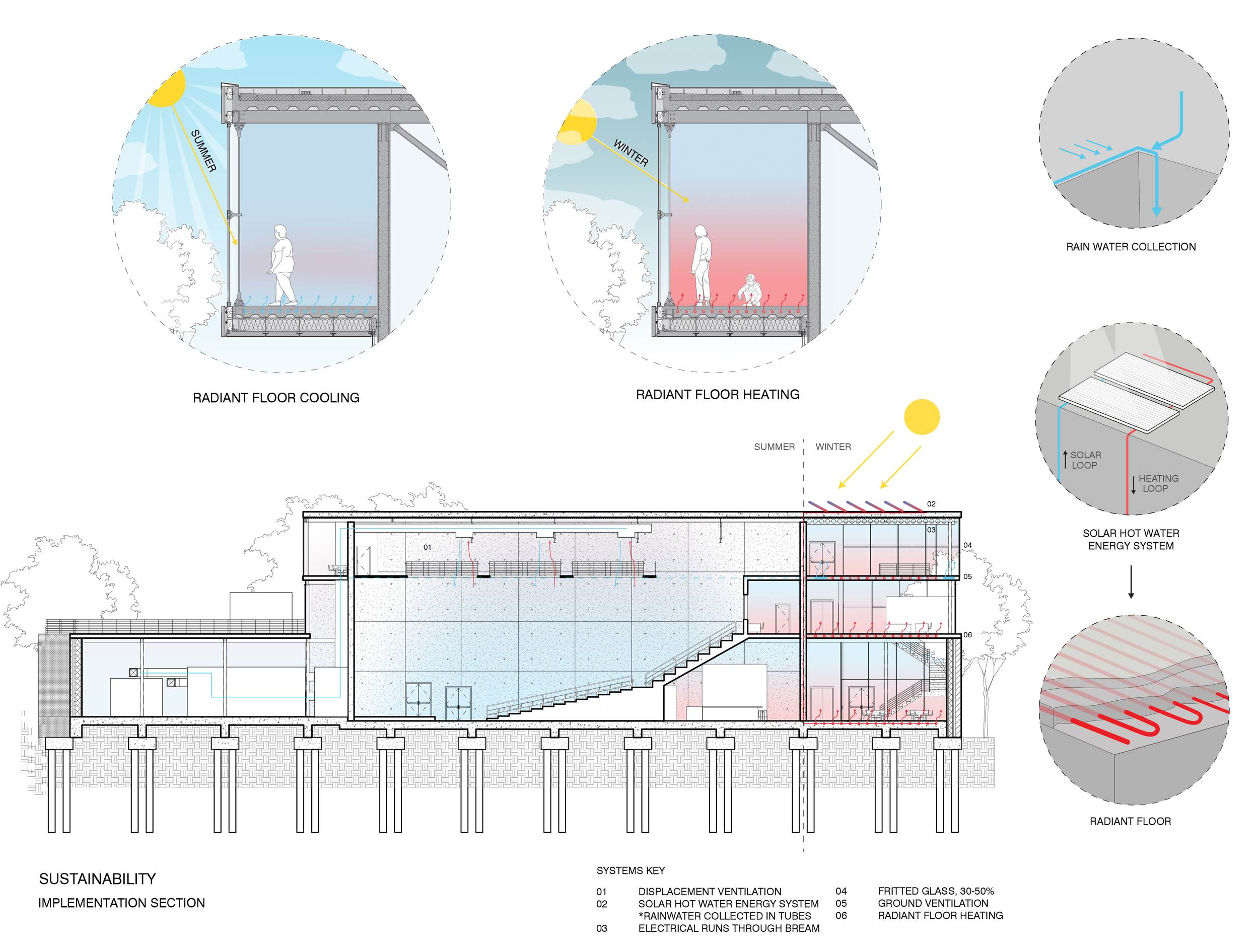Le Corbusier in Algeria — A Recontextualization of Corbusier’s Imaginary Algeria through the French Colonial Narrative —
Spring 2017
To perpetuate the massive, cultural and economic hegemony France had over its myriad colonies during its imperial age, it was necessary to undermine and reinvent existing cultural, social, and economic frameworks within its colonial subjects. Alongside this radical alteration of existing systems were a series of schemes, both imagined and realized, that attempted to break down the existing built environments with the intention of further legitimizing French interests, whether through the expansion of economic networks or through the interruption of existing social systems in the colony. Algeria, as the primary locus and symbol of France’s colonial empire, was particularly affected by the influence of the French colonial narrative, and arguably was the focal point of French, colonial intervention into and development of the built environment; indeed, a plethora of architects were involved in this development, and therefore contributed (whether knowingly or not) to the establishment of French supremacy over Algeria. Amongst these architects included personalities as illustrious as Le Corbusier, who, visiting Algeria in the early 1930s, was unusually fascinated with the region enough to produce a series of seminal projects that characterize a transitional period between the purist, logical, “machine-age aesthetic” that characterized the earlier period of his opus and the more plastic, sensuous, “organic” (and, arguably, sustained by an archetypical impression of the romanticized Mediterranean) forms that characterized his later oeuvre. To contextualize this critical, liminal phase in Le Corbusier’s life (and therefore contextualize the development of his architectural modus operandi and ethos) it is necessary to expound and critically assess his vision of a new Algeria, and thus further contextualize him within the broad narrative of French colonialism and the legitimization of French hegemony over an imagined Other. Despite his cosmopolitan intentions in Algeria and his cursory fascination with the region, through a reading of Corbusier’s personal writings, sketches, and a further recontextualization of his oeuvre in relation to and through the lens of colonialism, it is averred that his projects and predilections for Algeria ultimately aided the institution of economic and cultural domination over France’s colonies and its imaginary Orient. This dialectic is especially visible when analyzing the relationship between his views on the Algiers Casbah and its internal and external relationships (influenced by a French colonialist narrative) and the reality of the Algiers Casbah itself.
Until 1830, the territory of present-day Algeria was a self-sufficient, semi-autonomous holding of the Ottoman Empire. A century later, French colonization had completely transformed the economy and underlying social and cultural framework of the country. French Algeria proper began in 1827, after a French naval blockade of the port of Algiers and the subsequent conquest of previously-Ottoman territory starting in 1830, a conquest which had lasted until the complete establishment of Algeria as a holistically-French territory in 1872. During this period, approximately 825,000 native Algerians had been killed, and a long history of genocidal hatred persisted, epitomized by the statement of one French author dictating “we hear it repeated every day that we must expel the native and if necessary destroy him."1 As a French statistical journal urged five years later, "the system of extermination must give way to a policy of penetration."2 The period of major Algerian resistance against French colonial authority ended in 1843, after French soldiers raided the camp of Abd El-Kader, the contemporary leader of the Algerian resistance. Over the span of three days, 500 French cavalrymen captured approximately 6000 members of the Algerian resistance, with Abd El-Kader fleeing into the hinterlands of Morocco, triggering French pressure on an independent Morocco and catalyzing the advent of the first Franco-Moroccan War in 1844, and beginning a long chain of events that would eventually lead to the subsequent French colonization of Morocco. By 1875, the French conquest of Algeria was complete and el-Khader had emoted on the state of Algiers built environment under colonial leadership:
I am grieved, o world, about Algiers! The French march on toward her . . .O regrets for Algiers, for its palaces. And for its forts which were so beautiful! O regrets for its mosques, for the prayers prayed there and for the marble pulpits . . . O regrets for Algiers, for its houses and for its so well-kept apartments! O regrets for the town of cleanliness, whose marble and porphyry dazzled the eyes! The Christians inhabit them, their state has changed! They have degraded everything, spoiled all, the impure ones! O regrets! How the port was embellished with the fortifications and ships! Algiers was a pincer to pull out teeth, the most courageous were afraid of her. O world, how was she taken?3
From 1848 until independence, the whole, Mediterranean region of Algeria was governed as an integral territory of France, with the area being considered and administered as a part of France (as opposed to another one of France’s myriad colonies) until Algerian independence in the mid-twentieth century. As one of France’s longest-held and most economically-important territories, hundreds of thousands of colonists (known as pied-noirs) immigrated from France to coastal Algeria; prior to Algerian independence, the pied-noir population of Algeria numbered over one million, compared to a total Algerian population of just over ten million—this population was primarily consolidated around the coastal, urban areas such as Algiers and Oran—the sheer amount of French immigrants to Algeria established major conflicts of identity in Algeria that are arguably still influencing the political and social direction of the country today. A century after French colonization was initiated, the country and its politics, economy, and underlying social and cultural framework had been radically altered. Under the stimulus of rapid industrialization, Algerian society endured in the space of decades a procedure that stretched over centuries in Europe, and Algiers, as the capital the French Empire in North Africa, was the principal locus of this change. In contrast to the relatively hands-off method of governance Algeria had been subject to under the Ottoman Empire, from whom the French Empire avowed to have “liberated” Algeria, the French colonial authorities set forth to restructure the whole of the country and its economic and social systems. Huge projects and massive infrastructural projects were undertaken in the region to create capitalistic networks linking agrarian regions to coastal, urban areas—the previous system of semi-autonomous regions and regional-capitals was exchanged for a system of hegemonic, French-dominated cities and the redirection of the economy such that it favored the burgeoning French Empire.
One of the hallmark pieces of the existing, urban fabric of Algiers included the Ottoman-era casbah. In this labyrinthian network of residences, mosques, schools, baths, markets, etc., the French military found a impenetrable, cryptic city that contained a dearth of the wide-spaces they were accustomed to in Europe. The French military, under the direction of the Minister of War in Paris, radically began to modify this existing conglomeration to accommodate French tastes. This included the piercing of the Casbah with major, arterial boulevards along its North-South axis, reflecting the trace of an ancient, Greco-Roman avenue and harking to the Haussmanian conjecture of utilizing wide boulevards as a method of accommodating troops and mobilizing the military. This widening of passages within the medina was an integral part of the establishment of French military hegemony over the existing, indigenous population, as the casbah itself became the center of militarized resistance to French authority within urban Algeria. Additionally, the French created a new, East-West artery through the dense, center of the Casbah to connect the city with the port, further establishing a network of capital through Algiers.
At the juncture of these two, aforementioned, arterial thoroughfares was placed a large square akin to those frequently seen in Paris, created initially for military exercises before becoming a place of government in Algiers. The new configuration of Algiers under French authority can accurately summarize the colonial rapport imposed: deprived, densely-populated alleyways of the old city juxtaposed in dramatic contrast with the wide, modern boulevards of the European sector. The French interventions and infrastructural projects in their new Algeria entailed expansive demolition of existing landmarks and buildings, whether private residences or communal buildings; public buildings were appropriated from locals for military and civilian use, with mosques being transformed into churches and houses transformed into European-style places of residence. In contrast to the archetypical, Muslim-city, where introverted facades and public, open spaces reveal relatively little urban hierarchy, the configuration and assemblage of open spaces in the European interventions, with their extroverted facades and positioning, reflect an imposed, power structure that was a desired visual order that the French sought to enforce.
Space was appropriated through procurement and the radical adjustment of existing systems of property and ownership. By overhauling the indigenous land and ownership system and applying European definition and interpretations of property over property owned under Islamic and tribal law, the French could arrogate land in the interest of a “common, public good.”4 To exacerbate matters, this all occurred at a time when waves of dislocated peasants from the wars of conquest were taking refuge in Algiers, weakening the already burdened, infrastructure of the city and granting greater legitimacy to the colonial government, its infrastructural projects, and its civilizing mission. This titanic alteration of property, economics, and society resulted in widespread, land speculation and the exodus of the native, middle and upper classes from the Casbah, resulting in the eventual ghettoization of the area.5 The reconstruction of the city in a European style supported a colonial discourse that infected all forms of architectural representation with decidedly prejudicial implication—to justify their incursions into the Algiers Casbah, the French relied on a colonial dichotomy of superiority/inferiority between the conqueror and the conquered; cultural and spatial traits that were treasured and valued by indigenous Algerians were antiquated elements of backwardness. The surviving area of the Algiers Casbah was turned into effective tool of propaganda and a supporting member of colonial discourse—the dirtiness, poverty, and segregated nature of the Casbah created an impression that the occupation of Algeria was not only essential but also equitable.
After the 1965 visit of Napoleon III to Algeria, the French government decided that it was no longer in their best interests to establish dominance over the city by massive, infrastructural incursions into the old city. Changes in French colonial policies towards Algeria could be indicated via the changing, official styles of architecture imposed by colonial authorities over time. In order reconstitute the image of the French Empire in Algeria, they pledged to preserve the remaining physical and symbolic fabric of the old Casbah. No longer did France view itself as a stern, occupying force but a tolerant protector Algerian identity and culture. Changes in the official architecture of Algeria gradually reflected this change in policy, with French and French-trained architects created Neo-Moorish, Mediterranean, and Arabicized architecture to appeal to the indigenous population and assert France’s position as a benevolent protector of Algeria, to whom Algerians should be complicit for the common good. A French official noted, “we have the impression, that the French Protectorate has finally reached an equilibrium. These beautiful monuments are the symbols of a politics of association [between France and Algeria].”6 It is important to note that by this period, many French writers and artists passing through North Africa had been incredibly disappointed to find in Algiers a “cheap imitation of Marseille.”7 With the preservation of the casbah and the introduction of an Orientalist built environment the French colonial authority could encourage tourism to Algeria through a policy that catered to the exotic tastes of Metropolitan France and the guaranteeing of a “native” habitat. The remainder of the Casbah was returned to its residents, and from this point forward, despite the continual influx of indigenous migrants from rural areas, colonial authorities made little attempts to provide for the old city, focusing all its efforts on the planning and improvement of the French quarters of the city. This separation and the attitude of the colonial government towards the native Algerians is perhaps best exemplified by the inscription on the apse of the church Notre Dame d’Afrique, which states “Pray for us and the Muslims.”
As previously mentioned, the establishment of French hegemony over Algeria and the legitimization of its civilizing mission in the region was symbiotically accompanied by the establishment of a dichotomy between the colonists and the colonized. This paradigm itself was not a novel creation, and its existence in the colonialist narrative could be traced as far back as the Enlightenment-era Orientalism. Indeed, French, Enlightenment-era thinkers from groups such as the Saint-Simonians (themselves active in major infrastructural projects across North Africa in the mid- and late-nineteenth centuries) increasingly fetishized a union between East and West and the creation of a “cosmopolitan” society via French cultural and administrative hegemony and a network of infrastructural projects tying together an increasingly expanding empire. The ulterior construction and reduction of Oriental (or Arab) identity is ultimately created by attributing qualities to it that were diametrically opposed to ones self-proscribed by Europeans. A common trope of depicting the East as a lethargic entity with decaying and unrealized potential was used as a justification for European colonial interests and the French appropriation of Arab lands. The establishment of the binary relationship between European and Oriental, self and other, masculine and feminine, dynamic and lethargic to create an imperialist narrative corresponds directly to a dialectic elaborated by Said in his Orientalism, and is arguably a dichotomy necessary for the establishment of colonialism itself.8 It is important to recognize that, at the time, it additionally was common to portray the East as sensuous, feminine other to be controlled and contained. Said himself, speaking of the colonialist narrative established by the Occident, declared “the space of weaker or underdeveloped regions like the Orient was viewed as something inviting French interest, penetration, insemination—in short, colonization . . . French scholars, administrators, geographers, and commercial agents poured out their exuberant activity onto the fairly supine, feminine Orient.”9
This information is especially important to contextualize the work of modern architects working in Algeria, such as Le Corbusier. Le Corbusier, commonly associated with the purity of the machine-age aesthetic, with its planar surfaces, and rationalized forms, first visited Algeria around the centennial in the early 1930s, and his imaginary projects created within the context of the French colonial narrative are considered be some to be an influential turning point in his career towards the more emotive, poetic, plastic, and distinctly Mediterranean. The contradictions of the city set against a majestic landscape of mountains and seas evidently moved him so much that he declared that the site was “perhaps one of the most beautiful in the world.”10 In his own writings, he corroborates a partiality towards the romanticized notion of French Algiers acting as an extension of Paris and completing an axis from Paris to Equatorial Africa, delineating French imperial expansion into the continent:
“Paris, Barcelona, Rome, Algiers. A unit extending from north to south along a meridian, running the entire gamut of climates, from the English Channel to Equatorial Africa, embracing very need—and every resource . . . Algiers ceases to be a colonial city; Algiers becomes the head of the African continent, a capital city. This means that a great task awaits her, but a magnificent future too. This means that the hour of city planning should strike in Algiers.”11
The language expounded by Le Corbusier gestures to an increased predilection and fascination with the concept of a Mediterranean union and an aesthetic that would influence his later work. It is also important to note that, despite his cosmopolitan intentions, he ultimately viewed Europeans and their Muslim constituents as being uniquely and holistically separated, in his future schemes interacting and overlapping only at specific, designated points.12
Le Corbusier’s personal infatuation with Algeria and his future association with the region could be traced additionally to his pilgrimage to the Mzab region of inner Algeria and its famous five cities in 1931. Passing through the region by car, the built environment of the pentapolis was shocking for him. There, he discovered an urban civilization that had endured for millennia, an insular world of a people that had been persecuted for their iconoclastic faith and differentiated form of Islam.13 He himself identified with these heretics, due to his own family lineage, as his ancestry could be traced to the Cathar apostates of the French Middle Ages, similarly persecuted for their adherence to a form of Christianity deemed heretical by the Catholic Church. The Cathars were subsequently persecuted, had their land stripped and possessions stripped from them, and were systematically exterminated in what is now known as the Albigensian Crusades of the early, thirteenth century. His sketches and studies from this period have been argued as influencing the forms of his later, more plastic work such as Notre-Dame du Ronchamp.
His affiliation with the Algerian landscape and its urban cores are incredibly evident in his Poésie sur Alger. In this text, Le Corbusier utilized the Western association of Algeria as a mysterious, supine, feminine other and provoked the association between his own works and Algerian women by describing his fascination with Algerian women and the hidden women of the Casbah. He likens the entire city of Algiers to a female body, claiming “Algiers drops out of sight; supple-hipped and full-breasted . . . A body which could be revealed in all its magnificence through the judicious influence of form and the bold use of mathematics to harmonize natural topography and human geometry.”14 The imagery presented both within and on the text itself corroborate Corbusier’s conflations of the female body with Algeria, as the cover image depicts a figural, distorted female body against the skyline of a new Algiers, caressed gently by a hand that has been interpreted as being the hand of the architect himself.15 This intentional positioning of figures by Le Corbusier asserts his own megalomaniacal vision over the colony, stating in clear terms his personal belief that the inherent beauty of Algiers can only be fully realized under his own personal direction (and, by extension, the direction of the colonizer against the colonized).
Additional sketches by Corbusier reveal that he was complicit in the dialogue that attributed to an exaggerated sense of sexuality to Muslim women; his erotic sketches of Algerian women and his fascination with Arab women is detailed in his personal accounts of his travels throughout the Orient. According to Zeynep Celik, he “fantasized about life in the seraglio, which would be filled with ‘divine, thrilling, odalisques . . . wearing around their naked ankles and arms . . . solid gold rings . . . like serpents. Loaded with gold and their nails painted in vermilion, they suffocated from waiting so long in their magnificent cages.”16 The inaccessibility of these women combined with their characteristic veils further provoked feelings of mystery to Corbusier, he expounds his fascination with the “delicious,” “innocent gazelle eyes” of the Arab women under the veil, to him, they were “hidden treasures in burgundy, ebony silk . . . just as exquisite as Persian cats,” and “charming in their mysterious black veils, their disquieting anonymity of identical silks, their hidden treasures all alike.”17
Corbusier’s fascination with Algerian women led to his eventual association of the casbah with the veiled woman.18 The veil, arguably the most loaded symbol of the Middle East, is now used by Corbusier as an icon representing the casbah, feminizing the Algerian colony and attributing with that feminization all the tropes standard to the orientalist, colonial narrative. Some scholars see this period in Le Corbusier’s pictorial representations as a break with the Orientalist method of framing the East as an exotic other, a model that alters the Other into an object of consumption. Others still argue that this expressionism reflected a wholly stylistic preference rather than a fundamentally changed view of the Orient: “like most Orientalists, [Le Corbusier] had a sincere respect for the culture of the Other, but never intended to reverse the position of dominion. From his paintings of Algerian mutes and reproposals of Delacroix’s Odalisque, to his fantastic plan for Algiers . . . he proved in every instance to be on the side of the white fathers.”19
As a proponent of modernist rationalism and the machine aesthetic, it is curious that he was so fascinated by the organization of the casbah. Previously in his life he had condemned meandering streets of variegated widths and slopes, closed views, and the asymmetrical urban layouts advocated by previous urban planners such as Camillo Sitte. However, Le Corbusier himself was entranced by this very, same type of urban fabric demonstrated in the Algerian Casbah—he even went so far as to praise the “intelligent urbanism of the Muslims, contrasting it to the impoverished cities of Europe.”20 In a sketch by Le Corbusier, he compares the European city with the Arab city and criticizes characteristics of the European city, with its massive towers and its “sinister courtyards.” Here, the European city is “stupidity” and an “urban disaster,” where “the civilized live like rats in their holes.” By contrast, in the Algerian city, he lauds the “terraces, suspended gardens, and grand bays that open to a landscape of dreams conquered by height.”21 What’s particularly notable about this drawing is that Le Corbusier noted an interest in the Arab house’s capacity to afford a life in coolness and tranquility, with the sea in the view of every house due to their terraced positioning towards the Mediterranean. The Casbah here is an “immense stairway, a tribune invaded at night by millions of adorers of nature.” Here, according to Le Corbusier, the “barbarians live in solitude, in well-being.”22 In his later schemes for the city of Algiers, he makes the claim that he affords these qualities he took from the Casbah to his proposals; ultimately, however, it can be argued that these qualities were applied only superficially and don’t reflect the specificity of Algerian society at large. Le Corbusier remarked of his own observations “I have neither the time to dedicate to necessary surveys, nor the taste to descend into a minute study to acquire a “scientific” judgement on people. I travel in opening my eyes and my ears, without a plan.”23
Among his first, and most famous proposals for the city of Algiers was the Plan Obus, dominated by a curve that distinguished itself from Le Corbusier’s earlier, Cartesian geometries, and which carried over into the more plastic forms of the architect’s later work. This project, undertaken without an official commission or endorsement, proposed that the business district of the city remain consolidated to the Quartier de la Marine, the only area of European settlement within the original Casbah. The most radical and intriguing part of the Plan Obus was the incorporation of a massive, infrastructural viaduct that would provide the structural framework for worker housing in the city. This elevated infrastructure would link a network of coastal cities in an efficient system of rapid transport. A radical departure from his previous plans, the Plan Obus fundamentally aligns itself against the static, Cartesian plans of projects such as the Plan Voisin due to its so-called “organic” qualities, including the capacity for organic growth, an additive, cellular structure, and a response to climate and geometry.24 As a symbiosis of architecture, people, and landscape, this project can be traced to Corbusier’s earlier sketch during his sojourn to Rio de Jainero, where he hastily sketched the landscape of the city and a cursory vision for a massive, infrastructural project above it that responded to the natural landscape of the Brazilian city.
The massive, fourteen floor, one-hundred-meter-high viaduct of the Plan Obus, which would link the European residential district with the European business district, contained residential cells for the colonized workers, a stirring image of a foreign, infrastructural network supporting European capitalism and colonialism literally supported on the backs of native, indigenous labor— from their cells, the Algerian natives could look out on the sea towards the distant land where the beneficiaries of their labor lived. In this structure, Le Corbusier proposed his alternative vision to the neo-traditionalist revivals contemporary in the Algerian protectorate, he imagined this infrastructure as a modern medina that would appease native sentiments. This new system of living, a cellular structure supposedly inspired by the traditional housing of the Casbah, was to operate “according to the conditions of North Africa.”25 However, unlike the Casbah, this infrastructural undertaking would be completely constructed of foreign materials, with foreign capital, and would largely be dependent on cooling technology and foreign construction methods; Le Corbusier’s personal notions of what constituted “Arab comfort” was decidedly a European, Orientalist prognosis. Indeed, “all Le Corbusier’s projects emphasized the importance of access to essential amenities such as clean air, access to the natural environment, healthy recreation in open space, etc.”; it can be argued, however, that his application of these criteria in his design for the Plan Obus did not profoundly consider the religious, social, symbolic, political meanings of space in Algerian culture and the paradigms of domestic, Algerian life before European colonization.26 For instance, Le Corbusier, although vaguely and cursorily accounting for a type of communal arrangement within the project, evidently did not account existing for extrafamilial institutions common within the Casbah such as the extended family, the clan, and the tribe. Traditional patterns of living and ownership had long been viewed as unfavorable by colonial administrators as impediments to European forms of capitalism. The introduction of housing based on qualities such as occupation and income was a method developed to break down traditional patterns within the Plan Obus. An excerpt from a 1951 development plan for a town in West Africa documents this attitude of the colonists towards the colonized:
As urbanization take place . . . tribal ties and discipline must be superseded by other loyalties if a coordinated law-abiding society is to emerge. This policy requires non-traditional types of housing and accommodation. The tribal compound has no place in the colony and is replaced by the private, family dwelling. Differentiation of dwelling standards is purely by income and all income groups are represented in each community.27
Thus, despite Le Corbusier’s cosmopolitan statements that the Plan Obus existed as a method meant to appease indigenous Algerians, his attempts to reconstruct their vernacular Casbah in a manner suited to the modern era, and his cursory fascination with the Arab city and lifestyle, it can be argued that his proposal rendered him complicit to the policies of the colonial authorities and the breakdown of traditional, Algerian society. Additionally, in his campaign for the implementation of the Plan Obus, Le Corbusier attempted to court not only the colonial authority but also representatives of private capital who could endorse it; the way he constructed his argument for the Plan Obus often focused on the financial implications of the scheme, and social benefits were often subordinated and curtailed for the sake of profit. Notably, the Plan Obus called for the demolition of the Quartier de la Marine to create a new business district with several office towers at its core. Rather than using his urban plan as an “economic means to attack the capitalist system,” Le Corbusier imagined an urban agglomeration with a monument to the capitalist system of colonialization at its center.28 The imposition of the Plan Obus, with its housing cells imposing a Westernized model of domestic life, would have transformed the indigenous population into complicit members of a French-themed, bourgeois society occupied by complicit consumers. Furthermore, with the working-class restricted to the viaduct and the middle and upper classes placed within the free-form redents of Fort l’Empereur, Corbusier’s Plan Obus would only have served to underpin the existing system of colonial, social stratification and its racial segregation.
Ironically, the original scheme of the Plan Obus had been derided as being overtly socialist by colonial authorities in Algeria. To silence the opposition of the European community, and in response to the sociopolitical zeitgeist during the time (with France and its colonies being under the administration of Vichy France) Le Corbusier made developments and modifications to his original Plan Obus over the course of the next decade. These successive schemes downplayed the plan’s original social and political elements that had been derided by French critics. In his final plan, the Plan Directeur, the relocated business district at the terminus of the viaduct became the locus for Corbusier’s vision, and the organizational system was downplayed in favor of a simple slogan proscribed to the project that was favorable to French authorities at the time: “Famille, Travail, Patrie.” Furthermore, the differentiation between these projects and his previous projects illustrate the seminal influence the region has had on the development of his architectural theory and praxis: “just as the Obus departed from the Cartesian world of the Ville Contemporaine, the plasticity of the skyscraper façade challenged the taut curtain walls of his earlier towers. The free plan that Le Corbusier had developed in the twenties was now complemented by a façade whose articulation was much more plastic . . . The skyscraper became in its final design ‘une pure architecture Nord-Africaine.’”29
Pivotal to this scheme was the relocation of the business center of Algiers from the Quartier de la Marine, near the existing Casbah, to Bastion 15, well within the European sector of Algiers. This alteration from the original Plan Obus demonstrates as submission to existing hierarchies of European economic and social dominance; the center of the city now belonged to the colonists and was not necessarily meant to be shared between the Algerian and the Frenchman. Indeed, in his previous writings, Corbusier fantasized about an Algiers that was destined to become the “Capital of North Africa,” a regional capital of a decentralized, Franco-Mediterranean economy, and like many literati of the time operating in France and Algeria, Le Corbusier imagined a holistic union between the Algerians and the French colonists; however despite all his proselytizing on an equitable, mutually beneficial relationship between the two parties, it was clear which member he considered to be superior, and under what direction the influence should be.
What’s particularly notable about every iteration of the Plan Obus was the method with which the scheme handled the existing Casbah. In every iteration, the casbah itself was completely preserved, with the viaduct system overlooking it. Le Corbusier’s segregation of the Casbah in his novel systems can be interpreted as being a symbolic gesture meant to refer to an ancient, idyllic time that captures his fascination with the Algerian past and the Arab city. It is important to note that the prescription of timelessness and primitiveness to non-European cultures is a central part of the Orientalist tradition that attributes immutability to the Islamic city, denying it change and expounding the differences between the static Arab and the dynamic, ever-changing European. Additionally, Le Corbusier’s plan acts as a construction of spatial and political power, with the dominating above, constantly supervising the dominated, natives below.30
The preserved Casbah itself, however, took on a completely different life in the eyes of the indigenous people. With French colonial policies restricting the growth of the casbah despite the increasing mobilization of the indigenous Algerians to Algiers and other urban centers (contributing to the epidemic of the bidonvilles), the casbah eventually became a militarized center for the Algerian resistance against colonial authority. As a pre-existing physical expression of indigenous culture before colonialism that had been subject to various, colonialist interventions, residents of the Casbah were only further galvanized in their sense of common responsibility, despite the spatial marginalization established by the French government and the numerous colonialist discourses that had characterized the casbah as mediocre, inadequate, insalubrious, and dirty. Through the Casbah, the indigenous population had discovered a sublime way of defying French colonial authority. Indigenous artists also joined the fray in providing an anti-colonial discourse, reacting to the popular portrayals of the casbah and the native population established by the pied-noir community. Native men were often portrayed as being savage, poor, dirty, dishonest, and lascivious, whereas native women, as seen prior, were depicted in their domestic spaces in alluringly erotic settings.31 The marginalization of the French colonial authorities consolidated the native community which later served in the armed struggle, and provoked feelings of nationalism against the French. Gradually, militant ideas began to spread within the population of the increasingly dense Casbah. The central location of the Casbah within the heart of Algiers and its compact, labyrinthian spatial configuration constituted additional, favorable factors for the execution of urban, guerrilla resistance. Describing the favorable conditions within the Casbah, Yacef Saadi, one of the chief architects of the Battle for Algiers, states “with its inextricable mass of alleyways, the Casbah is a vast labyrinth on which are overlaid thousands of accesses and unexpected gateways . . . with its circular and ascendant urban configuration, with its dead-ends, its anonymous and furtive doors, its inclined and intertwined walls—in short, with all its outlaw, architectural features—the Casbah is almost predestined to struggle and rebellion.”32 As a result, the French soldiers attempting to interrupt later rebellions during the War for Algeria constantly struggled against the Casbah and its complex, spatial character. General Jacques Massu, one of the leaders of the French army during the Algerian War, noted:
The streets form an inextricable labyrinth for anyone who does not know well the secret of the Casbah. In each step, we climb a few degrees, steps taken apart so obliquely that one needs a torch even by day to see where to walk. Most of the streets give onto a dead end. Quite often, where daylight does not even penetrate, even the streets become comparable to dark tunnels.33
The casbah, originally the source of community for the native, Algerian population, was in a sense almost predetermined to become militarized against sources of repression. When accounting for these peculiarities within the casbah, whether just the arcane, civilian nature of the Casbah to the eyes of outsiders, its symbolic value to both the indigenous Algerians and the French colonists, or its pivotal role as a militarized space central to the Algerian life and resistance, it becomes difficult to maintain the impartiality of Corbusier’s projects in Algiers, which always appeared to relate themselves to the Casbah in a position of superiority.
Despite Corbusier’s proselytizing on the role of his imaginary, Algerian schemes in providing a common, public good for both Algerians and the French in the colony, it is clear that Le Corbusier was not impartial towards which party should maintain a role of superiority within the region. This is not to say that Corbusier wittingly perpetuated the domination of Algerian natives, but simply to reiterate that he was a product of his time and was likely incapable of separating his oeuvre from the colonial context within which it was situated. His seminal Plan Obus, avowed by Corbusier as considering the “Arab comfort” that the indigenous were so accustomed to, fell short of considering the specific role of the built environment in Algerian society, and unwittingly imposed a system of European social codes over the Algerian natives. Additionally, in his further attempts he aligns himself with the capitalistic intentions intrinsic to the colonies by focusing primarily on the amplification of networks of production and the emphasis on the commercial aspects of the plan. Furthermore, he profoundly creates a hierarchy of power within his system that places the French at the top and the Algerians (quite literally) at the bottom, within their original Casbah. This Algiers period, as a liminal period demarcating “old” Corbusier from “new Corbusier,” arguably influenced his later production (which includes work as influential to the history of architecture as Notre-Dame du Ronchamp), and its merited recontextualization as an important part of the French colonialist narrative in relation to the built environment assists in a further comprehension of Corbusier’s opus as something partial and capable of assisting in the structuring of the dynamics of power.
1Kiernan, Ben. Blood and Soil: A World History of Genocide and Extermination from Sparta to Darfur. Yale University Press: New Haven, Connecticut. 2007, 374.
2Ibid.
3Djiar, Kahina Amal. “Symbolism and memory in architecture: Algerian anti-colonial resistance and the Algiers Casbah.” The Journal of North African Studies, 14:2, 186. 4Lamprakos, Michele. “Le Corbusier and Algiers: the Plan Obus as Colonial Urbanism.” Forms of Dominance on the Architecture and Urbanism of the Colonial Enterprise, edited by Nezar Al-Sayyad. Avebury. 1992. 186-187.
5Ibid.
6Lamprakos, Michele. “Le Corbusier and Algiers: the Plan Obus as Colonial Urbanism.” Forms of Dominance on the Architecture and Urbanism of the Colonial Enterprise, edited by Nezar Al-Sayyad. Avebury. 1992. 190
7Ibid. 191.
8Said, Edward. Orientalism. Penguin; London. 1977. 40-41.
9Ibid. 221.
10McLeod, Mary. “Le Corbusier and Algiers” Oppositions,19/20, edited by Kenneth Frampton. MIT Press; Cambridge. 1980. 57.
11Le Corbusier. La ville radieuse, 228
12Celik, Zeynep. “Le Corbusier, Orientalism, Colonialism” Assemblage,17. The MIT Press: Cambridge. 1992. 71.
13Gerber, Alex. “Le Corbusier et le mirage de l’Orient : l’influence supposée de l’Algérie sur son œuvre architecturale” Revue du monde musulman et de la Méditerranée, n°73-74, 1994. 365-366. Translated from original French.
14Le Corbusier. La ville radieuse, 260
15Celik, Zeynep. “Le Corbusier, Orientalism, Colonialism” Assemblage,17. The MIT Press: Cambridge. 1992. 71.
16Celik, Zeynep. “Le Corbusier, Orientalism, Colonialism” Assemblage,17. The MIT Press: Cambridge. 1992. 72.
17Favre, Tout l’inconnu de la casbah d’Alger, 10
18Celik, Zeynep. “Le Corbusier, Orientalism, Colonialism” Assemblage,17. The MIT Press: Cambridge. 1992.
19Ingersoll, R. “Letter to the Editor.” Journal of Architectural Education. 1989 20Lamprakos, Michele. “Le Corbusier and Algiers: the Plan Obus as Colonial Urbanism.” Forms of Dominance on the Architecture and Urbanism of the Colonial Enterprise, edited by Nezar Al-Sayyad. Avebury, 1992. 195.
21Le Corbusier. La ville radieuse, 230, 233
22Ibid.
23Gerber, Alex. “Le Corbusier et le mirage de l’Orient : l’influence supposée de l’Algérie sur son œuvre architecturale” Revue du monde musulman et de la Méditerranée, n°73-74, 1994. 366.Translated from original French.
24McLeod, Mary. “Le Corbusier and Algiers” Oppositions,19/20, edited by Kenneth Frampton. MIT Press; Cambridge. 1980. 59.
25Lamprakos, Michele. “Le Corbusier and Algiers: the Plan Obus as Colonial Urbanism.” Forms of Dominance on the Architecture and Urbanism of the Colonial Enterprise, edited by Nezar Al-Sayyad, Avebury, 1992. 200.
26Lamprakos, Michele. “Le Corbusier and Algiers: the Plan Obus as Colonial Urbanism.” Forms of Dominance on the Architecture and Urbanism of the Colonial Enterprise, edited by Nezar Al-Sayyad, Avebury, 1992. 200.
27King, Anthony D. “Exporting Planning: the Colonial and Neo-Colonial Experience.” Shaping an Urban World, edited by Gordon Cherry. St. Martin’s Press: New York. 1961. 224.
28McLeod, Mary. “Le Corbusier and Algiers” Oppositions,19/20, edited by Kenneth Frampton. MIT Press ; Cambridge. 1980.
29McLeod, Mary. “Le Corbusier and Algiers” Oppositions,19/20, edited by Kenneth Frampton. MIT Press ; Cambridge. 1980. 73.
30Celik, Zeynep. “Le Corbusier, Orientalism, Colonialism” Assemblage, 17. The MIT Press: Cambridge. 1992. 69.
31Djiar, Kahina Amal. “Symbolism and memory in architecture: Algerian anti-colonial resistance and the Algiers Casbah.” The Journal of North African Studies, 14:2, 191. 32Ibid. 194
33Djiar, Kahina Amal. “Symbolism and memory in architecture: Algerian anti-colonial resistance and the Algiers Casbah.” The Journal of North African Studies, 14:2, 194.
